The membranes are too long for a cooking oven, but you can use a heatgun and a vaccum cleaner, the molds can be made from wood with a router bit.
I've seen a guy in a RC car pit able to thermoform a rc car body with a bottle of soda and a heatgun.
Edit : if you are dubitative with the wood, you can make a PLA negative mold and use it to produce a positive mold with some plaster or refractory concrete.
If you are dubitative with the air gun technique and the pin hole drilling, you can make a positive and negative molds and heat everything.
I've seen a guy in a RC car pit able to thermoform a rc car body with a bottle of soda and a heatgun.
Edit : if you are dubitative with the wood, you can make a PLA negative mold and use it to produce a positive mold with some plaster or refractory concrete.
If you are dubitative with the air gun technique and the pin hole drilling, you can make a positive and negative molds and heat everything.
Last edited:
Yes, but the tricky part is to get the membrane in the "mold" for more than a couple of centimeters.
The friction will be to high for the part of membrane yet to be folded when pressing the two sides together.
When making an AMT membrane, the folds are not than many being vertical deep folds, so a folding tool is used.
To corrugate a planar you'll need hundreds of shallow folds; folding tool is not then practical.
The friction will be to high for the part of membrane yet to be folded when pressing the two sides together.
When making an AMT membrane, the folds are not than many being vertical deep folds, so a folding tool is used.
To corrugate a planar you'll need hundreds of shallow folds; folding tool is not then practical.
whohooo where did you get a swifle rottary blade ? thats goddamn awesome !! oh cameo 4.. nice must get me either the blade or both 🙂I've ordered a rotary blade to try it out, if I am lucky it will arrive before the weekend.
Another possible solution is to add a sticky stabilization layer on top of the foil before cutting. The idea is that this extra layer will be more stiff and prevent rips. Kind of how Silhouette sells iron on fabric stiffener to help cut fabrics where the glue is dissolvable in water. I just happen to have some vinyl transfer paper lying around so I will definently try that.
Until now I've used the transfer paper when I cut aluminum with pre applied adhesive, to transfer to the mylar. But it will be worth trying to first add a vinyl transfer sheet on the foil before cutting. I can always use another transfer sheet to transfer the now foil + transfer paper 🙂
Here are some membranes I cut last weekend before I realized they were all too big since Silhouette Studio rescaled my .dxf drawings...
View attachment 1339992
I did not read the whole topic yet. and im not sure you still have trouble to make your neo's bend in a curve ? 😉 but i bought custom neo rubber magnet for this purpose some while ago. its not as strongl.... (half that of a sintered N35) but it can take any curve and can be meters long. price is insane though... 12-15 euro a meter 🙁 i made this 180 Degree tweeter with it once when i was testing it.
It seems that the shop I bought 30 um aluminum foil sent the wrong stuff, they sent 20 um.
Here is the weight of the "30" um aluminum foil + kapton:
View attachment 1344168
And the actual 20 um aluminum foil + kapton:
View attachment 1344169
Mylar + 30 um self adhesive aluminum:
View attachment 1344167
For science I dug up the membranes from last week. I did cut off the bottom where I soldered the wires to ensure that the weights are comparable:
View attachment 1344180View attachment 1344165
And the kapton double adhesive is super heavy! Probably better to stay at 1 layer of adhesive 😆
I dug up a precision micrometer measurement tool and found out that the acrylic adhesive layer on the self adhesive aluminum is pretty thick. 30 um thick.
Interestingly enough the 12 um mylar + 30 um acrylic glue + 30 um aluminum membrane was still 1.4 dB more efficient than the 12 um kapton + 12 um silicone adhesive + 20 um aluminum foil membrane. The mylar-30um-alu is 0.93 grams, the kapton-20um-alu is 0.84. If we scale up the kapton membrane to 30 um then the weight would be 1.26 g. And 0.93 / 1.26 = 0.738 which in decibel just happens to be -1.3 dB which is pretty close to my -1.4 dB measurement.
View attachment 1344183
Next weekend I will test the self adhesive 30 um aluminum with non-adhesive kapton. I believe that will bring down the weight in line with the mylar and that the efficiency difference will be negligable.
But another test I want to see how thin I can get the glue layer if I use 3M 77 spray glue. I will email the supplier of the 30 um aluminum foil since they obviously sent the wrong thing, with actual 30 um aluminum then the kapton pre applied 12 um adhesive might yield the lightest membrane overall. Although something worth keeping in mind is that if I use the kapton adhesive or apply my own then the adhesive will be applied over the whole membrane. With the aluminum applied adhesive there will be no adhesive in the gaps, so the overall weight will be less than if applied over the whole membrane. In the end I will just have to test the different combinations and see what works best. A benefit of the self adhesive aluminum foil is that the backing paper and adhesive is extremely smoothly applied, so it is very easy to cut and doesn't self-weed as easy as if I spray the 3M ReMount adhesive where the glue has a larger grain size. That alone might make me go with the self adhesive foil even if is slightly heavier.
Ur foils look stunning by the way ! what kapton do you use >? since the only thin enough one i could find and used a few times is really expensive. and compared to Mylar still sounds... less. i bought a few rolls of 12/12 kapton 12 kapton and 12 adhesive. but the price is .... expensive. and if you ask me mylar sounds best.. when using alu tape like you do there is a barier of acrylic adhesive and it seems to prevent heat getting to the mylar. so you can actually drive them rather hard before the foil starts to losen, compares to a pre made laminate of alu and mylar. (the regular blue foil you probably know)
Nope, the curve of magnets is a solved problem for me. I went with lots of 12 mm long magnets and compared against a straight driver, no measurable difference. In fact I incorrectly used half the radius of the arc so I could proabably get away with longer magnets, say 24 or 30 mm without any measurable loss in efficiency. If I make another set of speakers that is, for the current pair I'll continue with 12 mm long magnets.and im not sure you still have trouble to make your neo's bend in a curve ?
I saw your experiments with them but given the price and the reduced efficiency I discarded the idea.its not as strongl.... (half that of a sintered N35) but it can take any curve and can be meters long. price is insane though... 12-15 euro a meter 🙁 i made this 180 Degree tweeter with it once when i was testing it.
Yup, kapton is definently not cheap! I bought from caplinq, a roll of 12 um kapton, no adhesive and a roll of 12 um kapton with 12 um and silicone adhesive. I would wager you have the same ones since I got the shop from other links here in the forum.Mylar still sounds... less. i bought a few rolls of 12/12 kapton 12 kapton and 12 adhesive. but the price is .... expensive
when using alu tape like you do there is a barier of acrylic adhesive and it seems to prevent heat getting to the mylar. so you can actually drive them rather hard before the foil starts to losen, compares to a pre made laminate of alu and mylar
I'm mostly afraid of long term damage. Say it gets baked under the sun and melts. I would prefer to not have to re mount a membrane in 5 years because of something dumb.
But in the end I will only use kapton if it sounds the same, which I will discover next weekend. I plan to run two drivers side by side where the only difference is kapton vs mylar and then live switch between them while listening.
I think pysiscs in the end will dictate that if two membranes measure the same wrt. FR, distortion and directivity, it will basically be SQ wise equal. I think you already found this out previously in this thread... there is simply no magic.. ;-)
//
//
You can press a preformed membrane near to the vitreous point in order to "win" over the plastic ?The friction will be to high for the part of membrane yet to be folded when pressing the two sides together.
Believe me, I've tried.
One solution is to have a gear rack kind of a tool as one side of the "mold" as long as the intended membrane and then press pieces of the opposite piece by piece until the whole base gear rack is covered. Then make friends with your local pizza hut owner.
Another solution is to fold it as you do with AMTs.
If you haven't made friends with your local pizza hut owner, the needed straps need to be very thin so that the folded membrane fits in an ordinary oven.
They also need to be strong enough to endure the actual the folding. Their width don't need to match the pleath depth; it's the straps offset in the folding tool that determines the pleath depth.
You'll need one strap for each side of the fold, so perhaps five to ten for every centimeter of the finished membrane.
For a 240 centimeter finished membrane you'll need more than a thousand straps.
Then there's the actual folding that can be very time consuming and it requires a close attention during the process.
But, it's doable. It all comes down to finding the right strap material with a suitable thickness and width.
Do you have any suggestions?
Sorry for the thread takeover, OllBoll.
But sometimes discussions like these can actually lead to something.
At least you'll have to re-evaluate your solutions.
One solution is to have a gear rack kind of a tool as one side of the "mold" as long as the intended membrane and then press pieces of the opposite piece by piece until the whole base gear rack is covered. Then make friends with your local pizza hut owner.
Another solution is to fold it as you do with AMTs.
If you haven't made friends with your local pizza hut owner, the needed straps need to be very thin so that the folded membrane fits in an ordinary oven.
They also need to be strong enough to endure the actual the folding. Their width don't need to match the pleath depth; it's the straps offset in the folding tool that determines the pleath depth.
You'll need one strap for each side of the fold, so perhaps five to ten for every centimeter of the finished membrane.
For a 240 centimeter finished membrane you'll need more than a thousand straps.
Then there's the actual folding that can be very time consuming and it requires a close attention during the process.
But, it's doable. It all comes down to finding the right strap material with a suitable thickness and width.
Do you have any suggestions?
Sorry for the thread takeover, OllBoll.
But sometimes discussions like these can actually lead to something.
At least you'll have to re-evaluate your solutions.
Maybe you could heat up the folding tool you have Solhaga and add a motor to slowly rotate the folding tool .Keeping the alu film at the sides it might hold the shape till it cools off .
Maybe 2 folding tools, synkronised , One for heating one for cooling.
Maybe 2 folding tools, synkronised , One for heating one for cooling.
Isn't kapton harder to corrugate?
No, not with my thickness of aluminum at least. The kapton membranes corrugate as well as the mylar ones, and given how thick my alu is it holds its shape pretty well. The "worst" at holding the shape (6 um mylar + 14 um alu) is nowhere close as stiff as the 12 um mylar / kapton + 30 um alu but still stiff enough to hold the corrugations.
And because of that I have not found any reason to investigate heat forming the membrane, since just the aluminum is enough for my drivers.
I think I have found the reason for why the 12 um mylar + 20 um alu membrane in my previous post distorted a lot.
The glue had released under the contacts and adjacent to it, the noise / distortion was probably the contact rattling. The reason it released is probably due to heating when soldering but also that with the 77 spray glue the glue itself has grains, and is not as evenly and smoothly applied as with the self adhesive or kapton tape configurations. Because of this problem I am leaning towards using factory applied glue, which means either self adhesive aluminum foil or kapton tape with pre applied adhesive.
I made a new 12 um kapton + 20 um alu membrane and the plan is to try it tomorrow, and also do the mylar vs kapton comparison. It was quite fiddly to cut and glue the 20 um alu foil so I'm leaning more and more to just go with the self adhesive 30 um aluminum foil.
The glue had released under the contacts and adjacent to it, the noise / distortion was probably the contact rattling. The reason it released is probably due to heating when soldering but also that with the 77 spray glue the glue itself has grains, and is not as evenly and smoothly applied as with the self adhesive or kapton tape configurations. Because of this problem I am leaning towards using factory applied glue, which means either self adhesive aluminum foil or kapton tape with pre applied adhesive.
I made a new 12 um kapton + 20 um alu membrane and the plan is to try it tomorrow, and also do the mylar vs kapton comparison. It was quite fiddly to cut and glue the 20 um alu foil so I'm leaning more and more to just go with the self adhesive 30 um aluminum foil.
I have kapton vs mylar data!
12 um mylar + 30 um aluminum with acrylic self adhesive
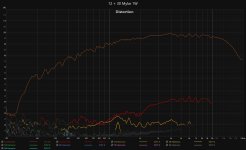
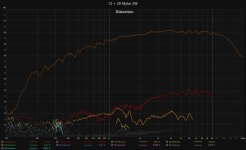
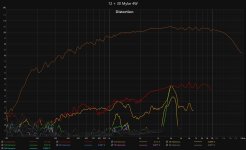
12 um kapton + 30 um aluminum with acrylic self adhesive
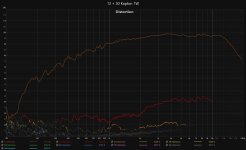
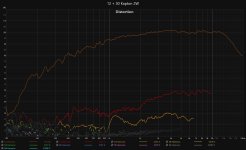
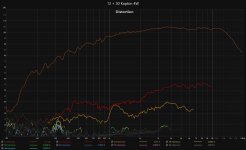
12 um kapton with 12 um silicone adhesive + 20 um aluminum
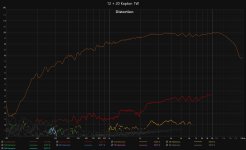
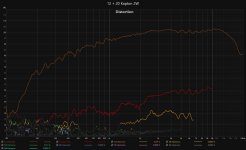
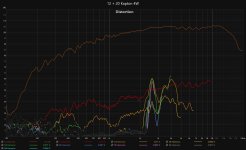
And now the same distortion spike as before so I got suspicious, I think it is a measurement error. And it turns out it is, it is the mic clipping. I tested with 3x mic distance and the problem went away, I guess the drivers are too efficient in the treble 🙂
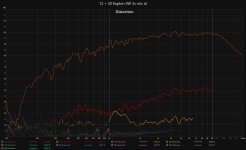
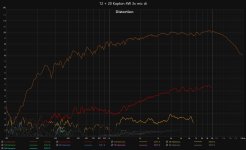
And EQed flat
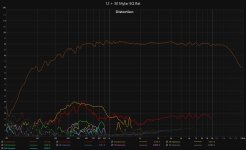
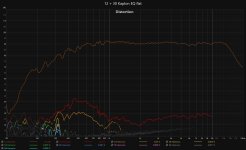
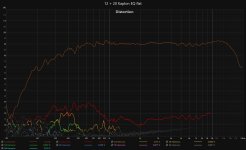
Awesome so far, but I had time over and started wondering... I wonder how much the membrane can take until it melts? And the answer was... more than I could push into it with my current amplifier 😆. I started blasting 20W to seehow the distortion looks, and it can handle it no problem. I also started blasting a 1 khz sine wave at 40W continously for 1 minute and then touch the traces to see if they get hot but nothing. And no issues with the membrane afterwards. If I want to melt the drivers I'll have to do new tests in the future where I skip the padding resistor to bump resistance, it got pretty hot to the touch 🔥 but I should have an amp lying around such that I could try pushing up to 400W through the driver. If 100-400W through 1/6 of the full driver doesn't melt it then nothing will 🙂
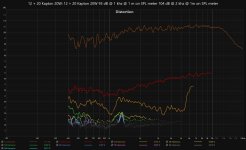
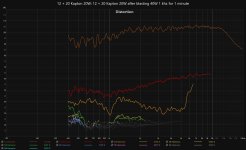
I also did some high SPL flat EQed measurements:
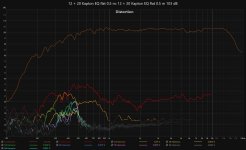
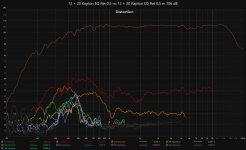
Sound impressions:
I could not hear any significant difference between mylar vs kapton, so I will go with kapton for my final driver. If anything the kapton membranes do seem to have lower distortion, which is suprising but this mylar membrane is not the same membrane as last week and both this one and the one last week shows higher 3rd order sitortion than 2nd in the SPL normalized tests so seems repeatable. Or maybe the problem is that the mylar is too tensioned, since it is easier to "stretch" to make it lie flat when applying the self adhesive aluminum since it is much wider and I can stretch it to a wooden frame where the kapton is only 100 mm wide and I have to get creative when stretching. But I don't think I will investigate further since I have already determined that kapton is as good or better, and I would prefer to use the kapton anyway since it is more heat resistant.
It looks like the 20 um alu foil performs the best, so I will have to iterate to fix my cutting process such that I can cut full length membranes reliably with the 20 um alu foil.
And on the topic of power, the membrane can handle a lot more power than I will need. Given the current efficiency and that I will have 6x the length (but shaded so ~ 4x after shading) the power handling should be no issue at all. I expect the final driver to be 90 dB @ 1m or more, so 100W would yield 110 dB which is far more than I need, but even if I wanted to the membrane would handle it without any problems. (I like quiet listening, but I want to be able to handle loud spikes without distortion for dynamic range)
12 um mylar + 30 um aluminum with acrylic self adhesive



12 um kapton + 30 um aluminum with acrylic self adhesive



12 um kapton with 12 um silicone adhesive + 20 um aluminum



And now the same distortion spike as before so I got suspicious, I think it is a measurement error. And it turns out it is, it is the mic clipping. I tested with 3x mic distance and the problem went away, I guess the drivers are too efficient in the treble 🙂


And EQed flat



Awesome so far, but I had time over and started wondering... I wonder how much the membrane can take until it melts? And the answer was... more than I could push into it with my current amplifier 😆. I started blasting 20W to seehow the distortion looks, and it can handle it no problem. I also started blasting a 1 khz sine wave at 40W continously for 1 minute and then touch the traces to see if they get hot but nothing. And no issues with the membrane afterwards. If I want to melt the drivers I'll have to do new tests in the future where I skip the padding resistor to bump resistance, it got pretty hot to the touch 🔥 but I should have an amp lying around such that I could try pushing up to 400W through the driver. If 100-400W through 1/6 of the full driver doesn't melt it then nothing will 🙂


I also did some high SPL flat EQed measurements:


Sound impressions:
I could not hear any significant difference between mylar vs kapton, so I will go with kapton for my final driver. If anything the kapton membranes do seem to have lower distortion, which is suprising but this mylar membrane is not the same membrane as last week and both this one and the one last week shows higher 3rd order sitortion than 2nd in the SPL normalized tests so seems repeatable. Or maybe the problem is that the mylar is too tensioned, since it is easier to "stretch" to make it lie flat when applying the self adhesive aluminum since it is much wider and I can stretch it to a wooden frame where the kapton is only 100 mm wide and I have to get creative when stretching. But I don't think I will investigate further since I have already determined that kapton is as good or better, and I would prefer to use the kapton anyway since it is more heat resistant.
It looks like the 20 um alu foil performs the best, so I will have to iterate to fix my cutting process such that I can cut full length membranes reliably with the 20 um alu foil.
And on the topic of power, the membrane can handle a lot more power than I will need. Given the current efficiency and that I will have 6x the length (but shaded so ~ 4x after shading) the power handling should be no issue at all. I expect the final driver to be 90 dB @ 1m or more, so 100W would yield 110 dB which is far more than I need, but even if I wanted to the membrane would handle it without any problems. (I like quiet listening, but I want to be able to handle loud spikes without distortion for dynamic range)
Last edited:
Yes, Kapton due to the absence of the high order grass (bush? 🙂) harmonics in the "lows"... never nice.
//
//
What was your target range... from 500? Should be really good.
Yup.
I would love to cross at 300 hz, but 400 hz is probably more realistic. But if I have to push it to 500 hz it would not be the end of the world, I believe 500 hz would still integrate with the woofers nicely.
This is just 1/6 of the full driver though so the full driver should have much better low frequency extension, time will tell exactly how much better. In the end I will cross as low as I can as long as the planar driver has equal or less distortion at the crossover freuquency than the woofers.
- Home
- Loudspeakers
- Planars & Exotics
- DIY midtweeter planar, physically curved and shaded to be used in a dipole CBT